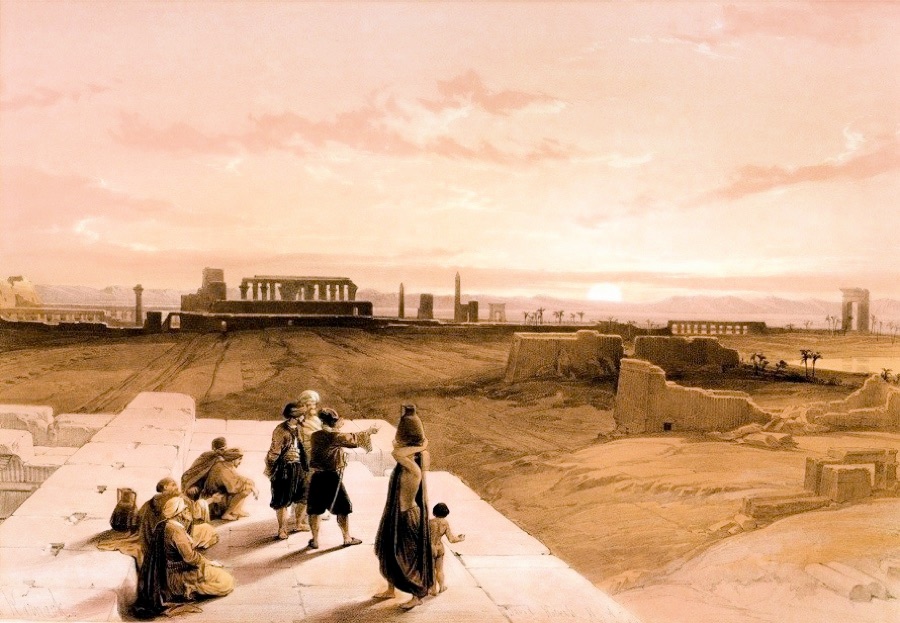GENERAL VIEW OF THE RUINS OF KARNAC FROM THE WEST.
THIS view, which embraces the whole range and extent of these stupendous ruins, is taken, looking towards the east at sunrise, from the summit of a small temple that is situated near it.
On the extreme left, towering over every other object, rises the great propylon, to which an approach from the Nile was made. At nearly right angles, lay another approach, through an avenue of sphinxes, supposed to have extended from Luxor; of this avenue traces are here seen. Between the great propylon and the grand hall lay the outer court, having covered corridors on either side, supported by columns; and up the centre, by which the great hall was approached, there were originally twelve isolated and enormous columns: each of these bore an allegorical attribute of Amunre, the Theban Jupiter. These columns were twelve feet in diameter, and placed in rows; but one only of the columns is now erect, the others lie in ruins. Beyond this court, through a second propylon and a magnificent though ruined gateway, lies the entrance to the grand hall of columns - a structure which, in extent and vastness, has no parallel in the world. This hall terminates in another propylon, beyond which, in a small court, are two obelisks; one only is still standing. Another pylon succeeds; and in the next court, which is peristyle, is the celebrated obelisk, which was dedicated to Amunre by Amunneitgori, in honour of Thothmes I.; it is ninety-two feet high, and eight feet square, in one block of red granite. Its companion lies overthrown and broken. To this court two dilapidated propylæ, and a smaller area, succeed; and the granite gateway of another propylon forms the entrance to the court of the sanctuary, which also is built of red granite, and divided into two apartments, and surrounded by numerous small chambers exquisitely wrought. This, which is the oldest part of the Temple, is of the time of Osirtesen I., the Pharaoh of Joseph. Further on appears an extensive columnar edifice, erected by Thothmes III., and a series of smaller halls and chambers terminates the extremity of the Temple; in these are found the names of the predecessors of Thothmes III. Still beyond, on the extreme right, rises an enormous gate, one of the grand entrances in the brick wall by which the whole of this sacred edifice was surrounded. In this direction, the bright surface of a tank, or small lake, appears: such reservoirs were always adjuncts to their temples. On the right, below the observer, are seen the ruins of three propylæ, through which another of the twelve approaches to the Temple lay. Colossal statues were placed before each of these, but they are now broken and destroyed; and these ruined propylæ were, during Mr. Roberts’s stay, being taken down, to build with the materials a manufactory of saltpetre, with which the whole ground around Karnac is impregnated. We must regret such further destruction; but the original builders of this great Temple, evidently obtained many of their materials from previous structures - a proof that the Thebans were as unscrupulous in their day in destroying the temples of their forefathers.
There is one point of striking interest in this view. Between the solitary column in the great court, and the entrance to the grand hall, a lateral gate is seen, which connects a court, built by Shishak, with the great Temple. On the walls of this gate, Champollion found the figure of a bearded man, like a Jew, bound, and under it the cartouche of Malek Judah, King of Judah. The hieroglyphics record the victories of Shishak, the Pharaoh of Scripture, who, in the time of Rehoboam, the son of Solomon, invaded Jerusalem, and carried off vast treasures. Here the event is recorded in the language of ancient Egypt, and confirms the narrative in Scripture, 1 Kings, xiv.
This general view of the great Temple of Karnac exhibits its entire extent from the great propylon to the extremity of the Temple, a length of one thousand one hundred and eighty feet, and the outer wall of circumvallation exceeded two thousand in length; which fully justifies the statement of Diodorus, that the circuit of the most ancient of the four temples of Thebes measured thirteen stadia - a mile and five furlongs.


